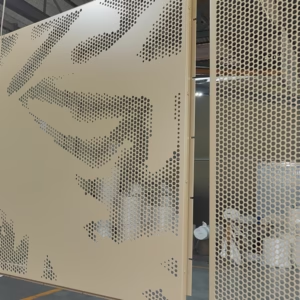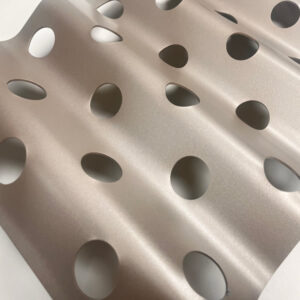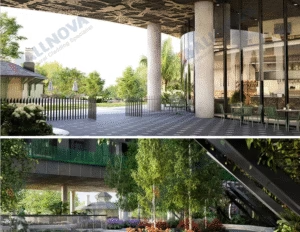1. مقدمة عن الجدران الستائر المصنوعة من الألواح الألومنيوم
أن حائط ساتر من الألواح الألومنيوم هو نظام تكسية خارجية متعدد الاستخدامات يجمع بين إطارات من سبائك الألومنيوم ومواد حشو متنوعة مثل ألواح الألومنيوم أو الزجاج أو الألواح المركبة. لا تحمي هذه الواجهة المصممة هندسياً المباني فحسب، بل تعزز أيضاً من جاذبيتها الجمالية. تشمل المكونات الرئيسية ما يلي:
- الألواح: عادةً ما تكون ألواح ألومنيوم بسماكة 1.5 مم فأكثر أو ألواح مركبة (على سبيل المثال، طبقات ألومنيوم بسماكة 0.5 مم تحيط بقلب من البولي إيثيلين بسماكة 3-4 مم).
- الطلاءات: يضمن طلاء الفلوروكربون الاحتفاظ بالألوان لمدة 25 عاماً ومقاومة التآكل.
- الهيكل: تعمل المقويات ورموز الزوايا على تقوية الألواح، مما يتيح أشكالاً معقدة مثل الأقواس أو المجالات.

2. التطور وديناميكيات السوق
2.1 التطور التاريخي
- السبعينيات والتسعينيات: برزت صناعة الحوائط الساترة المصنوعة من الألومنيوم في الصين، وانتقلت من الألواح الزجاجية إلى الألواح المعدنية بسبب مرونة تصميمها.
- من عام 2000 إلى الوقت الحاضر: أدى التقدم في المواد المركبة والطلاءات (مثل PVDF) إلى توسيع نطاق التطبيقات، حيث يهيمن الألومنيوم الآن على الأسواق العالمية.
2.2 محركات النمو
- التحضر: التطور السريع في المدن يغذي الطلب على الواجهات الحديثة والمتينة.
- السياسات الخضراء: تعزز معايير مثل GB/T 34327-2017 المواد الصديقة للبيئة والقابلة لإعادة التدوير.
- الابتكار: تعمل خطوط الإنتاج المؤتمتة والطلاءات الذكية على تعزيز الكفاءة والأداء.

3. مزايا الجدران الساترة المصنوعة من الألومنيوم
3.1 متانة ومقاومة للتآكل لا مثيل لها
جدران ستائر ألواح الألومنيوم تتفوق في البيئات القاسية بفضل قدرة الألومنيوم الطبيعية على تكوين طبقة أكسيد واقية. وهذا ما يجعلها مثالية للمناطق الساحلية أو المناطق ذات الرطوبة العالية حيث يمثل التآكل مصدر قلق كبير. عند معالجتها بالأنودة أو الطلاء بالفلوروكربون (PVDF)، تقاوم هذه الألواح البهتان والطباشير والتآكل لأكثر من 25 عاماً. تُظهر الاختبارات الصارمة الحد الأدنى من التدهور حتى بعد التعرض الطويل للأشعة فوق البنفسجية والأمطار الحمضية ورذاذ الملح، مما يضمن المظهر الجمالي والسلامة الهيكلية على المدى الطويل.

3.2 القوة الإنشائية تلتقي مع كفاءة الوزن الخفيف
على الرغم من تركيبتها خفيفة الوزن, ألواح الألومنيوم توفر نسب قوة إلى الوزن مثيرة للإعجاب. وبفضل قوة الشد التي تصل إلى 280 نيوتن/مم²، فإنها تتحمل أحمال الرياح الشديدة وقوى الزلازل، مما يجعلها مثالية للمباني الشاهقة والمناطق المعرضة للعواصف. وتقلل طبيعتها خفيفة الوزن من الحمل الكلي للمباني، مما يبسط التصميم الإنشائي ويقلل من تكاليف الأساسات. هذه الميزة مهمة بشكل خاص في مناطق الزلازل أو المناطق ذات التربة الرخوة.
3.3 تعدد الاستخدامات الجمالية ومرونة التصميم
يفضل المهندسون المعماريون جدران ستائر الألواح الألومنيوم لحرية تصميمها. هذه الألواح متوفرة بألوان صلبة أو تشطيبات معدنية أو زخارف خشبية/حجرية، وتتكيف هذه الألواح مع أي طراز معماري - بدءاً من الأبراج البسيطة للشركات وحتى الأماكن الثقافية الطليعية. ويمكن تقويسها أو تثقيبها أو دمجها مع عناصر زجاجية/معدنية لإنشاء واجهات ديناميكية. على سبيل المثال، يستخدم مجمع تانغتشن ييبين السكني في شنغهاي ألواحاً مؤكسدة بالذهب لإضفاء مظهر عصري فاخر، بينما يدمجها برج الأميرة في دبي في نظام زجاجي - ألومنيوم موحد للحصول على أناقة سلسة.

3.4 الأداء الحراري وكفاءة الطاقة
عند إقرانها مع فاصل حراري التكنولوجيا أو النوى المعزولة، تعزز ألواح الألومنيوم كفاءة الطاقة بشكل كبير. تعمل الفواصل الحرارية على تعطيل نقل الحرارة، مما يقلل من تقلبات درجات الحرارة الداخلية واستهلاك طاقة التدفئة والتهوية وتكييف الهواء بما يصل إلى 301 تيرابايت 3 تيرابايت. في المناخات الباردة، يعني ذلك انخفاض تكاليف التدفئة؛ وفي المناطق الحارة، انخفاض متطلبات التبريد. تشتمل العديد من الأنظمة الآن على مواد معاد تدويرها أو ألواح كهروضوئية، بما يتماشى مع أهداف الاستدامة العالمية وشهادات المباني الخضراء مثل LEED.

3.5 الاستدامة وقابلية إعادة التدوير
ألومنيوم هي مادة قابلة لإعادة التدوير بمقدار 100%، وغالبًا ما تُصنع ألواح الحائط الساتر من خردة ما بعد الاستهلاك. يقلل هذا الإنتاج ذو الحلقة المغلقة من التأثير البيئي، مما يقلل من انبعاثات الكربون بنسبة تصل إلى 95% مقارنة باستخراج الألومنيوم البكر. وبفضل عمرها الافتراضي الذي يتجاوز 30 عامًا والحد الأدنى من احتياجات الصيانة، تساهم هذه الألواح في خفض تكاليف دورة الحياة وتقليل نفايات البناء. كما أن قابليتها للتكيف في عمليات التجديد تزيد من جاذبيتها الصديقة للبيئة، حيث يمكن تحديث الهياكل القائمة دون هدمها.
4. التطبيقات في مختلف الصناعات

4.1 المباني التجارية
- مراكز التسوق, المكاتبو الفنادق استخدام ألواح الألومنيوم لجمالها العصري ومتانتها.
4.2 المساحات العامة
- المطارات, المستشفياتو المتاحف إعطاء الأولوية لفوائدها الصحية والصوتية والصيانة.
4.3 المشاريع السكنية
- شقق راقية و فيلات اعتمادها لتصاميمها الأنيقة وكفاءتها الحرارية.
5. مزايا وتطبيقات الجدران الساترة المصنوعة من الألومنيوم
I. المباني الشاهقة والمجمعات التجارية: الكفاءة الإنشائية تلتقي مع الجاذبية الجمالية
في الهياكل فائقة الارتفاع, ألواح الألومنيوم التفوق في مقاومة الرياح والخصائص خفيفة الوزن.
- دراسة حالة برج شنغهاي: تستخدم ناطحة السحاب التي يبلغ ارتفاعها 632 مترًا جدرانًا ستائرية من الألومنيوم مخصصة تم تحسينها من خلال تحليل العناصر المحدودة، وتتحمل أحمال الرياح الإعصارية من الدرجة الثانية عشرة مع تقليل الأحمال الهيكلية بمقدار 181 تيرابايت 3 تيرابايت مقارنةً بالكسوة الحجرية.
- السيارات الهجينة الموفرة للطاقة: تدمج منطقة الأعمال المركزية في بكين بين الواجهات الزجاجية والألومنيوم، وتحقق وفورات في الطاقة تبلغ 40% من خلال معاملات التظليل القابلة للتعديل وأنظمة الحائط الساتر القابلة للتنفس.
- اقتصاديات دورة الحياة: على الرغم من أن الاستثمارات الأولية أعلى، إلا أن تكاليف دورة الحياة أقل بـ 351 تيرابايت 3 تيرابايت 3 تيرابايت أقل من المواد التقليدية، مع قيم متبقية تصل إلى 801 تيرابايت 3 تيرابايت 3 تيرابايت بسبب قابلية إعادة التدوير.

ثانياً. المباني السكنية: الارتقاء بالجماليات مع صيانة منخفضة
الاستفادة من المشاريع السكنية المتميزة متانة الألومنيوم ومرونة التصميم.
- مشاريع هانغتشو للتطويرات الفاخرة: تضمن الألواح المطلية بالفلوروكربون 3 مم الاحتفاظ بالألوان لمدة 25 عاماً، مما يعزز قيمة العقارات بمقدار 18% في المناطق الراقية.
- تقنية التنظيف الذاتي: تقلل الألواح المطلية بالنانو في نينغبو من تكاليف التنظيف بمقدار 60,000 يوان صيني سنويًا، حيث يقل تلوث السطح بمقدار 801 تيرابايت 3 تيرابايت عن الطلاء التقليدي.
- اتجاهات التخصيص: شهدت عمليات تجديد الفلل في شينزين باستخدام الألواح الخشبية والحجرية المكسوة بالحبيبات الخشبية ارتفاعًا في أسعار إعادة البيع بمقدار 12% بسبب تحسين جاذبية المظهر الخارجي.

ثالثاً. المباني العامة: المتانة الوظيفية للأماكن ذات الكثافة المرورية العالية
تتطلب البنية التحتية العامة المرونة والقدرة على التكيف الجمالي.
- دار الأوبرا في قوانغتشو: ألواح ألومنيوم مزدوجة المنحنيات مصنوعة بدقة 0.5 مم عن طريق نمذجة معلومات البناء، مما أدى إلى اختصار وقت البناء بمقدار 401 تيرابايت و3 تيرابايت مع إنشاء معلم حضاري.
- ابتكارات المطارات: يستخدم مبنى الركاب رقم 4 في مطار شينزن الدولي ألواحاً مدعومة على شكل قرص العسل، مما يحقق خفضاً للضوضاء بمقدار 60 ديسيبل وتحسيناً في وضوح الكلام بمقدار 45%.
- الالتزام بالسلامة من الحرائق: تعتمد مراكز المؤتمرات الألواح المقاومة للحريق المصنفة A2، والتي تنجو من اختبارات الحريق لمدة ساعتين لضمان الإخلاء الآمن.

رابعاً. المباني الثقافية والتعليمية: التصميم الأخضر يلتقي مع التراث
تعطي المؤسسات الأولوية للاستدامة وراحة الركاب.
- مكتبة سوتشو الثانية: تعزز ألواح الألومنيوم المثقوبة (مسامية 35%) الإضاءة الطبيعية بمقدار 30% وتقلل من استخدام الطاقة في التدفئة والتهوية وتكييف الهواء بمقدار 18%، مما يمنح شهادة LEED الذهبية.
- المساحات التعليمية: تعمل الألواح غير اللامعة منخفضة التوهج في المدارس الدولية في شنغهاي على تقليل وهج الفصول الدراسية من 82 إلى 45، بما يتوافق مع معايير الإضاءة EN 12464.
- الرمزية الثقافية: يدمج متحف جينغدتشن للسيراميك أنماطًا محفورة بالليزر باللونين الأزرق والأبيض في ألواح خفيفة الوزن، ويدمج بين التقاليد والهندسة الحديثة.






